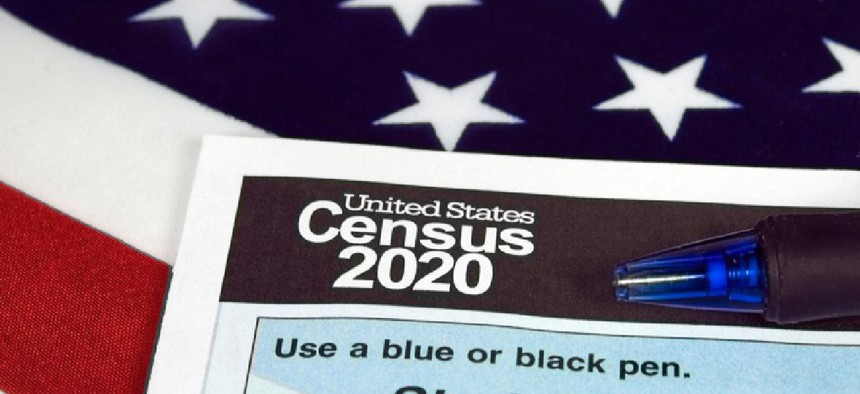Census details cyber strategies, awards last major IT contract

Census Bureau officials sought to address swirling concerns about what the agency is doing to protect sensitive response data and mitigate cyber risks.

The Census Bureau on Aug. 3 sought to address swirling concerns about what it’s doing to protect sensitive response data and mitigate cyber risks, as officials announced that the agency had awarded its last major IT contract.
Public perception of the bureau's ability to safeguard response data are a major self-identified risk area. The bureau’s cybersecurity posture and potential data vulnerabilities have drawn widespread attention from lawmakers, cybersecurity experts and other observers of the constitutionally mandated count.
At the most recent quarterly program management review, Census Bureau CIO Kevin Smith offered the most in-depth public description to date of the bureau’s cybersecurity posture and strategies.
“I want to stress that protection of the data we collect is census’s highest priority,” he said.
In July, a group of former cybersecurity officials raised concerns about the lack of information about how the bureau plans to protect Americans’ data. Smith made clear that all data on the census site, both while in transit and at rest, is encrypted.
“I, as the census CIO, am not able to protect your personal device,” he said. “But what I am able to do is make sure, once you get to the site, that is protected… Once you connect to the internet self-response site, all of the communication between your device and our website is 100 percent encrypted.”
Another precaution the bureau is taking is making sure respondents don’t need to download or store any data on personal devices to respond to the census, Smith said. He added that the bureau would try to educate respondents about ways to protect personal devices used to respond to the census.
To limit malefactors from impersonating the Census Bureau to try and steal data, Smith said the bureau is scanning for such sites and has purchased domain names that resemble the official self-response site.
He also emphasized the bureau is working with industry and the intelligence community about what threats are out there, and has services in place to monitor site activity to protect against data theft and distributed denial of service attacks.
“Everyone in the census, contractors as well as employees, knows the value of our data, and knows that their responsibilities exist for stewardship,” he said.
In addition to protecting data submitted to the census data collection site, Census also must cover the thousands of devices provided to enumerators. For those, Smith said, the bureau is using two-factor authentication, and “once the enumerator collects the data on the device and clicks submit, the data is off the device.”
“It is gone, it is removed, it is locked away in a vault inside of the Census,” he said. “The exposure to data on this phone is minimal because there is not going to be a lot of data on this phone. It’s going to remove itself as soon as it’s connected to the network.”
Al Fontenot, associate director of the decennial census programs, also announced the award of the field IT contract. Unisys won the three-year, $102 million deal to equip, install, test, support and decommission all IT equipment for the roughly 250 area offices and 1,500 remote workers across the country. The bureau initially planned to award the contract before the end of 2017, but a series of delays pushed that date until Aug. 3.
Another change since the last program management review was the downgrading of costs associated with late changes to the 2020 form — added after the late reinstatement of a citizenship question — from the highest, “red” level risk.
The bureau also provided an update on its critical 2018 end-to-end test, its last chance to test operations in a real-world environment.
With the dress rehearsal wrapping up at the end of the month, Alexa Jones-Putoff of the Decennial Census Management Division provided an update on the Providence, R.I., site. As of August 2, 52.3 percent of the population self-responded to the questionnaire, outperforming the 49.3 percent projection. And of the more than 147,000 self-respondents, 61 percent answered via the internet.
It’s worth noting the citizenship question, the future of which is currently making its way through the court system, does not appear on the 2018 forms. Census is accepting public comments on the addition of the citizenship question until Aug. 7.
One challenge Fontenot noted from the 2018 test was that the bureau “was unable to hire our planned number of enumerators.” In Providence, which has a similar unemployment rate to the country at large, the bureau planned to hire 1,049 enumerators for the 2018 test, but ended up deploying only 735.
“This clearly underscored an important need in 2020, and that’s a strong recruiting campaign as a part of our media efforts and a full engagement of our partnership staff and our partners in our communities to help recruit more field workers,” he said.
The next major deadlines come in October, when the bureau plans full implementation of the communications program and hopes to have more than 100 partnership specialists on board and working on the census.
NEXT STORY: Collins-Smee leaving GSA


